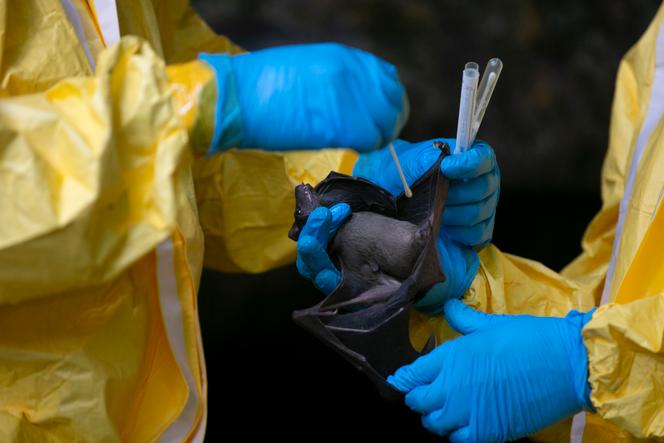
Is this a science fiction movie? A dystopian series? Six men in yellow overalls, covered from head to toe, laboriously climb to a lost cavity in the heart of the virgin forest, in search of emerging viruses. These researchers from the Franceville Interdisciplinary Medical Research Center (CIRMF) go to the Zadié cave, in north-eastern Gabon, to study bats, suspected of being at the origin of most of the transmitted epidemics. to humans in recent years: SARS in 2003, MERS in 2012, Ebola and today SARS-CoV-2, at the origin of Covid-19 which paralyzes the planet.
The path is strewn with humus, bark and scorched leaves which exude the scent of the virgin forest of this country whose tropical, hot and humid climate, and lush fauna offer a particularly favorable ground for the proliferation of viruses, what the local populations are not aware of. But little by little, the smell of damp earth gives way to that of guano, the excrement of bats. At first light, it becomes suffocating. The air becomes unbreathable. Silver-shimmering bees and butterflies swirl around the concentrated faces of virus hunters. Under the suit, the heat is stifling. Sweat beads on researchers’ goggles. Above them, the treetops are lost in threatening clouds and the lianas seem to descend from the sky.
Suddenly, like an open mouth on the forest, the entrance to the cave appears. A loud stream of bats escapes from the gaping black hole. Their droppings cover a thick white coat sliding the ground and the rock faces. ” Pull ! “, orders Professor Gaël Maganga, until the net used to capture mammals is stretched across the entire width. The animals sense the presence of visitors. The flow dries up slightly. But when one of the scientists comes forward and turns on his flashlight, a swarm of bats rush towards the exit and the trap closes on them. The samples can begin.
A reservoir of 1.7 million unknown viruses
“What sex is it?” He is young! “exclaims Mr. Maganga, teacher-researcher at the University of Franceville, the third largest city in the country. Using sterile swabs, he takes oral and rectal samples. “Our job is to identify pathogens that could represent a danger for human populations and to understand inter-species transmission”, explains to AFP the scientist, also co-director of the Emergence of viral diseases unit of CIRMF, which houses one of the two P4 laboratories in Africa, an international classification authorizing the handling of the most dangerous viruses in these buildings hermetically closed.
On October 29, the UN Group of Experts on Biodiversity (IPBES) warned in a report that pandemics such as Covid-19 would multiply and cause more and more deaths, citing a huge reservoir of 1, 7 million unknown viruses in the animal world, including 540,000 to 850,000 “Would have the capacity to infect humans”. Moreover, 70% of new diseases (Ebola, Zika) and “Almost all known pandemics” (influenza, AIDS, Covid-19) are zoonoses, that is to say from animal pathogens.
“We must stop thinking that man is on one side and animals on the other. In terms of health, what happens to one will have an impact on the other. Protecting wild fauna, protecting nature is protecting man ”, emphasizes Pauline Grentzinger, veterinarian of the Lékédi Natural Park, which works for the preservation of biodiversity, very close to Franceville. “Human behavior is often the cause of the emergence of viruses. Today, with demographic pressure, the intensification of agriculture and even hunting, contact between humans and animals is more and more frequent ”, adds Professor Maganga.
Bats carrying the Ebola virus
In Gabon, all the Ebola epidemics were declared in the Zadié cave region, very close to the border with Congo-Brazzaville. CIRMF researchers took bats carrying the virus there, which allowed them to discover that the animal was the host organism at the origin of the epidemic. Professor Maganga also highlighted the presence of a certain number of coronaviruses circulating in these bats, some of which are close to human coronaviruses.
However, this does not prevent the villagers of the surroundings from entering the caves to hunt bats, just like the antelope, the gazelle or the monkey. In Gabon, despite the April ban on the sale of pangolins and bats, villagers continue to hunt down wild animals to ensure a livelihood in this remote region. “In one night, I can earn what I earn in a month”, argues Aristide Roux, 43, living in a village near the cave, who exposes on a trunk cut by the roadside a gazelle killed in the night. The Covid-19? “He has not yet reached the village”, slice the hunter.
For Just-Parfait Mangongwé, a 20-year-old native member of the CIRMF team, the people of his village “Do not believe” viruses. Hence the importance of “Raise awareness of these hunters who have always made a living from this resource”, says Professor Maganga.
–

/cloudfront-eu-central-1.images.arcpublishing.com/larazon/ZT556WTUI5CCDAMN5QQS3RUTMU.jpg)